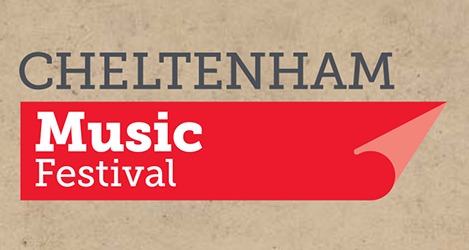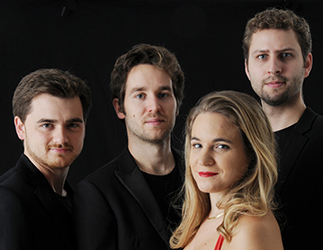 Here’s a suggestion: if a composer can’t summarise their programme note in fewer than a couple of hundred words, that’s a problem. Is that terribly controversial? Judging by what we were given at the Cheltenham Music Festival last Saturday, it is. This is not a local problem, though, it’s something that manifests itself all too often, composers seeking to convey at length not merely the inspiration for their music but a blow-by-blow account of what happens in it. It’s interesting that they deem this necessary. Does it suggest a lack of faith either in the audience or, more worryingly, in the music? It would be strange for a writer to introduce their novel with a breakdown of the structure and key plot-points; likewise with a programme note full of aural spoilers, it’s impossible to be drawn in and surprised by the music, as we already know what’s coming. Increasingly, programme notes seem akin to the abstracts that preface academic papers, and that’s not necessarily the ideal model for the concert hall. There are two caveats to this: first, it’s not just contemporary music that’s treated to such ‘programme essays’, and second, of course, one’s not obliged to read them at all. Of the first caveat, this is partly to do with the understandable desire for a degree of historical contextualisation, but regarding the second, i’ll come back to this shortly.
Here’s a suggestion: if a composer can’t summarise their programme note in fewer than a couple of hundred words, that’s a problem. Is that terribly controversial? Judging by what we were given at the Cheltenham Music Festival last Saturday, it is. This is not a local problem, though, it’s something that manifests itself all too often, composers seeking to convey at length not merely the inspiration for their music but a blow-by-blow account of what happens in it. It’s interesting that they deem this necessary. Does it suggest a lack of faith either in the audience or, more worryingly, in the music? It would be strange for a writer to introduce their novel with a breakdown of the structure and key plot-points; likewise with a programme note full of aural spoilers, it’s impossible to be drawn in and surprised by the music, as we already know what’s coming. Increasingly, programme notes seem akin to the abstracts that preface academic papers, and that’s not necessarily the ideal model for the concert hall. There are two caveats to this: first, it’s not just contemporary music that’s treated to such ‘programme essays’, and second, of course, one’s not obliged to read them at all. Of the first caveat, this is partly to do with the understandable desire for a degree of historical contextualisation, but regarding the second, i’ll come back to this shortly.
It’s not just about quantity, though, veracity plays a part too. If a composer really does feel the need to guide audiences both towards and through their pieces in a programme note, their music had better correspond to what they’ve written. In the case of Ryan Wigglesworth‘s Clocks from A Winter’s Tale, receiving its UK première by the Hallé directed by Jonathon Heyward on Saturday evening, it wasn’t at all convincing that that correspondence was really there. Wiggleworth talks a lot about time in his note: “the circularity of time, the warping of the listener’s perception of time, and the juxtaposition of ‘clock’ time and psychological time”. The intended musical manifestation of this is via a contrast between melody, which moves freely, and pulse, which is fixed and regular. The latter derives its impetus from the use of tubular bells – arranged prominently at various points on stage – which Wigglesworth describes as ‘clocks’, acting to try and instill regularity in tension with the melodic impulse tending towards metric fluidity. But there was no such tension. There was drama, certainly: cast in three movements, for the most part it sounded precisely like the soundtrack to an imagined series of film scenes. Not always; here and there it deviated somewhat from the conventions of that genre. Not often though, essentially charting a polite, pleasant pathway through a trio of episodes alternating in terms of scale, focus and intensity. Some sought to cause more havoc, attaining considerable energy, others probed a more atmospheric purpose. Yet these supposed ‘clocks’ were a complete red herring (or perhaps, due to its overwhelmingly cinematic qualities, one should call it a ‘MacGuffin‘), they neither represented nor provoked anything remotely rhythmic or metric, they were flaccid, random bursts that in actuality emphasised pitch, not rhythm. Does this mean the piece failed? This is where the specifics of the programme note caused real friction, as one sought to reconcile intention with outcome. In this sense, the piece didn’t succeed, but in hindsight, the fact that Clocks from A Winter’s Tale lacked anything memorable – when melody had been so key to its stated purpose – seems like a much more significant problem.
 Returning to that second caveat: to read or not to read – that, indeed, is the question. In the Saturday afternoon concert given by the Piatti Quartet – bearing the bold title ’21st Century String Quartet’ – this question took an interesting turn. With two of the three pieces, Darren Bloom‘s Five Brief Lessons (a world première) and Joseph Phibbs‘ String Quartet No. 1, reading the programme note didn’t feel like an option – they had to be read. In Phibbs’ case, this was due to the convolution of the work’s structure, supposedly operating on multiple levels simultaneously. Without the programme note, i’m not convinced i’d have been able to follow the work at all, not in this instance due to a lack of memorability, but to the stop-start nature of the work. (This was another example of a programme note being at odds with the music; Phibbs’ used the word ‘dovetail’ to refer to one particular division, but at no point were the sections even slightly dovetailed; however, the obvious breaks turned out to be a handy way of keeping track of where we were, so i’m treating that as a positive.) The work’s cordiality came to feel pretty relentless after a while, but then there are far worse ways to spend 24 minutes. Its convolutions just about saved the day, though it feels as though its structural joins could do with some additional aural adhesive to make the whole feel more convincingly cohesive. In Bloom’s case, the programme note, despite being absurdly lengthy, was undeniably fascinating. Here was the most specifically detailed programme note of all, speaking about all manner of physics-related phenomena, the five movements titled ‘General Relativity’, ‘Quantum Mechanics’, ‘A Brief History of the Universe’, ‘Standard Model’ and ‘Theory of Everything’. What Bloom had set up here might well be called ‘Schrödinger’s programme note’: until one actually heard the music, it was both apposite and irrelevant at the same time. And then we heard the piece, and thankfully it turned out to be the former. However, for very different reasons from Phibbs’ quartet, without the programme note i’m not convinced Bloom’s music would have made any impact whatsoever. It meandered, wobbled, slid, moved rapidly, petered out, became fierce, cooled off and became vague. It was all highly variegated, clearly the result of underlying technical and inspirational processes, and the Piatti Quartet deserves major kudos for tracing the work’s contours with such clarity. Yet putting the programme note aside, it didn’t really engage at all. It was all effect and no apparent cause, like a journey that only makes sense when staring doggedly at the map: listening along with the notes, everything seemed clear, or at least explainable, but on its own terms, it simply baffled. In this respect, perhaps it resembles a lot of physics quite precisely.
Returning to that second caveat: to read or not to read – that, indeed, is the question. In the Saturday afternoon concert given by the Piatti Quartet – bearing the bold title ’21st Century String Quartet’ – this question took an interesting turn. With two of the three pieces, Darren Bloom‘s Five Brief Lessons (a world première) and Joseph Phibbs‘ String Quartet No. 1, reading the programme note didn’t feel like an option – they had to be read. In Phibbs’ case, this was due to the convolution of the work’s structure, supposedly operating on multiple levels simultaneously. Without the programme note, i’m not convinced i’d have been able to follow the work at all, not in this instance due to a lack of memorability, but to the stop-start nature of the work. (This was another example of a programme note being at odds with the music; Phibbs’ used the word ‘dovetail’ to refer to one particular division, but at no point were the sections even slightly dovetailed; however, the obvious breaks turned out to be a handy way of keeping track of where we were, so i’m treating that as a positive.) The work’s cordiality came to feel pretty relentless after a while, but then there are far worse ways to spend 24 minutes. Its convolutions just about saved the day, though it feels as though its structural joins could do with some additional aural adhesive to make the whole feel more convincingly cohesive. In Bloom’s case, the programme note, despite being absurdly lengthy, was undeniably fascinating. Here was the most specifically detailed programme note of all, speaking about all manner of physics-related phenomena, the five movements titled ‘General Relativity’, ‘Quantum Mechanics’, ‘A Brief History of the Universe’, ‘Standard Model’ and ‘Theory of Everything’. What Bloom had set up here might well be called ‘Schrödinger’s programme note’: until one actually heard the music, it was both apposite and irrelevant at the same time. And then we heard the piece, and thankfully it turned out to be the former. However, for very different reasons from Phibbs’ quartet, without the programme note i’m not convinced Bloom’s music would have made any impact whatsoever. It meandered, wobbled, slid, moved rapidly, petered out, became fierce, cooled off and became vague. It was all highly variegated, clearly the result of underlying technical and inspirational processes, and the Piatti Quartet deserves major kudos for tracing the work’s contours with such clarity. Yet putting the programme note aside, it didn’t really engage at all. It was all effect and no apparent cause, like a journey that only makes sense when staring doggedly at the map: listening along with the notes, everything seemed clear, or at least explainable, but on its own terms, it simply baffled. In this respect, perhaps it resembles a lot of physics quite precisely.
Mark-Anthony Turnage‘s Contusion opened the concert, the world première of a recently-revised version. Turnage had outsourced his programme note, but it was at least short and concise, and in any case his use of Sylvia Plath’s eponymous dark late poem in no way sought a direct correlation. This was music not about specifics but diving deeply into the implications and generalities of the profoundest sullen, claustrophobic melancholy. Turnage set things up such that the quartet were simultaneously locked in place yet lyrical, the Piatti Quartet movingly capturing the depth of emotion bubbling beneath their cycling movements. Above all, though, Turnage explored an interesting form of volatility, caught between this same lyricality and distortion, the intense richness and beauty in the material being regularly undermined, by excessive bow pressure and sul pont weakness among other means. It was also held in an uncomfortable tension where an underlying impulse to free-wheel was held in check through the music being grounded in a metric pulse that was often very apparent (presumably the same kind of tension Ryan Wigglesworth had aspired to create). Few mainstream composers channel melancholy with more directness and honesty than Turnage, and in this piece, Plath’s suicide – which occurred a mere eleven days after writing the poem – feels both understandable and inevitable. A devastating performance of a desperate piece.
